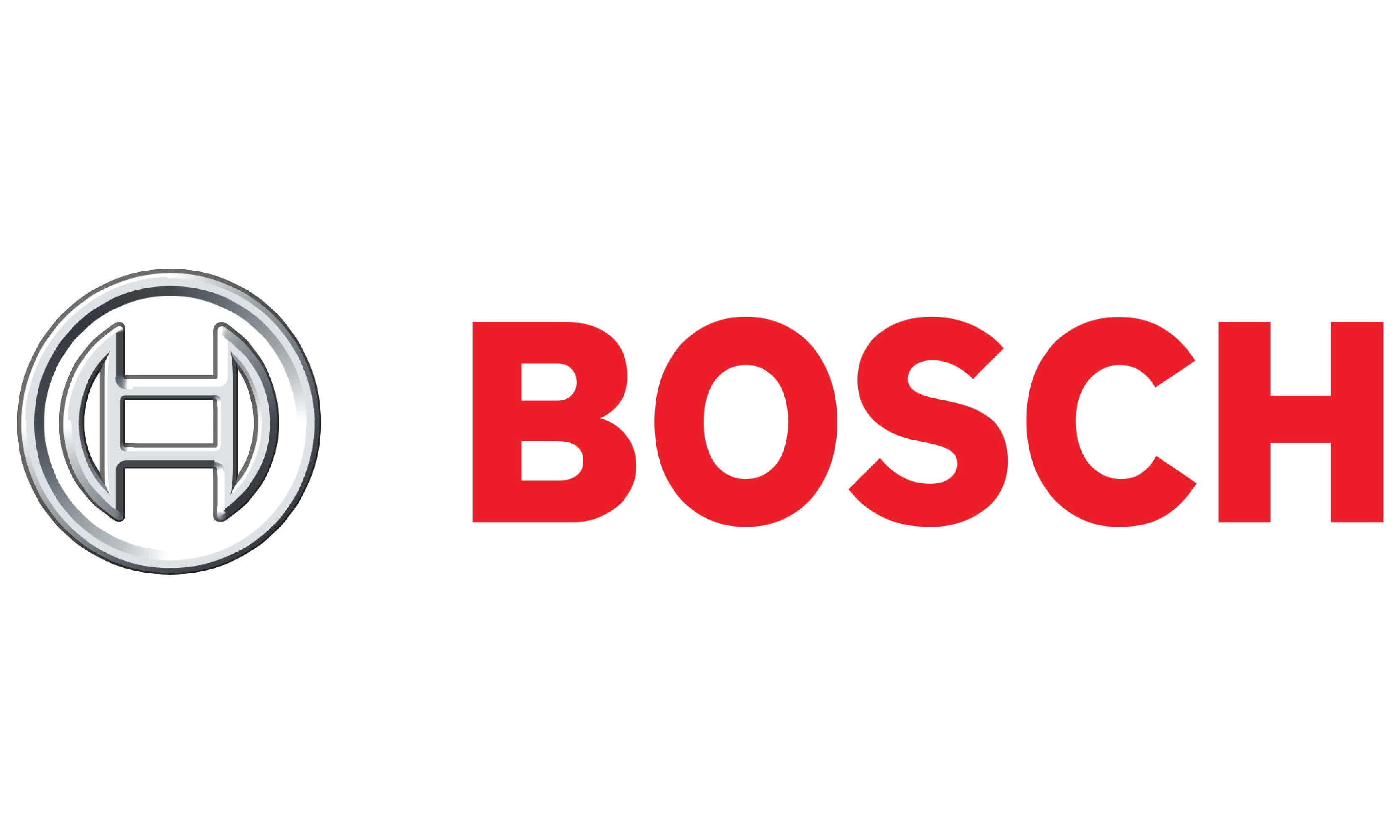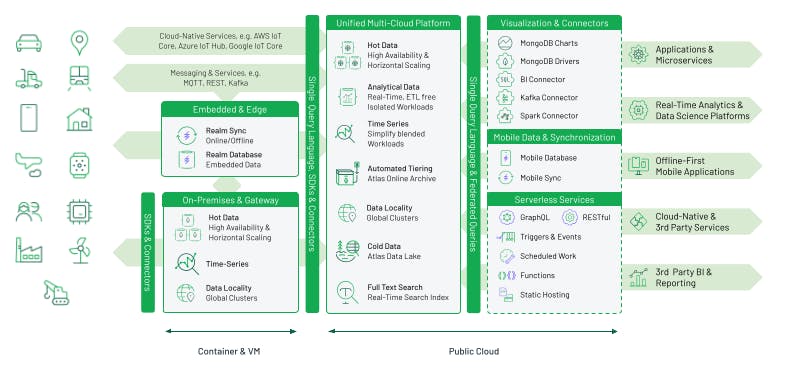THE INTERNET OF THINGS (IOT)
IoT Database: Choosing the Best Data Platform for Your IoT Needs
Capturing Value from the IoT
Industry Leading IoT Platforms are Powered by MongoDB


IoT Database Features with MongoDB
High-Speed Data Ingest and Real-Time Analytics
Event-Driven, Real-Time Architecture
Intelligent Edge
Fast, Flexible Development Experience
Our Intelligent Data Platform supports your IoT apps from edge to core. From the devices at the edge of the network to the IoT applications at the core, our Application Data Platform accelerates and de-risks the delivery and operation of your IoT applications. We start with MongoDB, the world’s most popular database, and bind in complementary technologies such as Apache Kafka to become part of an integrated, event-driven IoT platform.
Time-Series Data - Simplified
Realm Sync: Reliability in a Disconnected World
Our Application Data Platform Supports Your IoT Apps from Edge to Core
MongoDB Atlas
MongoDB Atlas is our on-demand, fully-managed, and global database-as-a-service (DBaaS) that runs on all leading cloud platforms so you can focus on apps, not ops.
A leader in the DBaaS space, Atlas radically simplifies development and operations, provides a persistence layer for event-driven architecture, and distributes data to consumers whenever and wherever needed.
Atlas lets you scale at the click of a button, in response to an API call, or fully automatically as loads grow, to keep up with the demands of your microservices—with no downtime, full security, and complete data protection.
Our newly available Time-Series Collections in MongoDB allow you to capture, process, and interact with Time-Series data with the same tools and simplicity as with other MongoDB data. New date operators and window functions give you insight in real-time to enable business applications that work in the now.
MongoDB Change Streams enables applications to stream real-time data changes in the database by leveraging MongoDB’s underlying replication capabilities. Change Streams can notify your application of all writes to documents (including deletes) and provide access to all available information immediately as changes occur in the database.
Applications can consume change streams directly via a message queue, but MongoDB’s Atlas Triggers provides a serverless way of consuming change stream events. MongoDB Change Streams drives Atlas Triggers to create responsive, event-driven pipelines.
Triggers can execute MongoDB Functions on predefined schedules or in real-time, responding to database changes or user authentication events.
Learn More →
MongoDB Realm
MongoDB Realm is part of our mission to get the database out of the way of developer productivity.
Realm is a serverless application platform that provides an elastically scalable infrastructure for handling requests and coordinating cloud service and database interactions. Think of Realm as adding value to your business applications by removing the need for tedious boilerplate code and automatically managing your application’s backend.
With Realm, there is no need to monitor and manage requests per second. The Realm platform takes care of the infrastructure, allowing you to focus on the high-value parts of your applications.
Realm accelerates development with simple, secure access to data and services to help you build the fastest, most reactive, always-on apps and get them to market faster while reducing operational costs and effort.
Realm works with any MongoDB Atlas cluster and contains these client components:
MongoDB Realm SDK to leverage the power of the lightweight Realm database on mobile and IoT edge devices.
MongoDB Realm Sync to sync data changes between MongoDB Realm instances on the edge and MongoDB Atlas.
Full Data Lifecycle Management
MongoDB’s data platform capability supports the entire data lifecycle from ingestion, storage, querying, real-time analysis, and visualization all the way through to online archiving. With MongoDB Atlas you can not just historically couple, but even query across hot and archived data. You can easily configure your system to ensure the best balance between real-time query speed and storage efficiency for your use-case.
MongoDB’s IoT Reference Architecture
MongoDB is your partner of choice when it comes to IoT databases. MongoDB offers a wide range of products and solutions that will simplify your IoT architecture.

Analytics with MongoDB
MongoDB Connector for Apache Spark
Connector for BI
MongoDB Charts
Why MongoDB?
Best way to work with data
- Ease: Documents match objects in code, making it faster and easier for developers to build new IoT apps. JSON is the language of APIs, which means you can use the same data model and syntax from the device to the back end. This increases developer productivity and enhances both efficient API design and data model consistency.
Flexibility: Add new time series data elements, sensors, and devices without the need to wrangle with database schema changes.
Versatility: Query IoT data any way you want to support rich application functionality, real-time analytics, and user experience.
- Integration: Work seamlessly with all of the leading systems for streaming data, machine learning, BI, and more.
- Security: Robust access controls, auditing, and encryption controls protect valuable IoT data both in flight and at rest.
Intelligently put data where you need it
MongoDB is distributed by design. Atlas lets you precisely control where you place data globally so you can ensure fast performance anywhere across all of your IoT and enterprise data.
Scalability: Hundreds of sensors today, millions worldwide tomorrow; Atlas horizontally scales out your database globally as your needs demand.
Locality: Distribute data globally for optimal performance or bind it to a specific geographic region for regulatory compliance.
Workload Isolation: Ingest vast streams of sensor data and analyze it to learn from it all in real time, without any data movement or resource contention.
High Availability: Your connected assets are always generating data, so built-in redundancy and self-healing recovery ensure that your data platform is always on regardless of planned and unplanned downtime.
Freedom to run anywhere
MongoDB offers a unified experience that gives you the freedom to run anywhere. Gain total deployment flexibility and build a ubiquitous data layer from your data center to the cloud and your IoT devices.
Portability: Run the same data platform everywhere, with a single API for your developers to use from the edge to the cloud.
Synchronization: Gain end-to-end data management and movement from edge to cloud with bi-directional and seamless synchronization.
Global Coverage: Deploy IoT around the globe, in your own data centers, and with the MongoDB Atlas fully automated global cloud service available on 60+ regions from all the major cloud providers.
No Lock-in: MongoDB does not bind you to a specific IoT platform; get the benefits of a multi-cloud strategy and avoid vendor lock-in.
With You Every Step of the Way
Featured Resources
FAQ
Are IoT Databases Necessary?
The Internet of Things is not only about connecting devices to the internet. It’s mostly about collecting, processing, and analyzing data. For this reason, a database appropriate for IoT data is essential to the success of your IoT project. MongoDB has a flexible data schema that can accommodate your IoT sensors’ data. It is also scalable and highly available. In the recent version, 5.0, it also offers time series collections which are optimized for IoT data.
What Should You Look for in Your IoT Database?
Relational Databases vs. NoSQL for IoT Development
What are the Suitable Databases for IoT?
To ensure success for your IoT project, you will need a database that can accommodate the IoT sensors data. IoT data has many different forms and often changes with time. This is why MongoDB is a great choice for IoT applications. It offers a flexible data schema that easily accommodates change, and when used in the cloud with MongoDB Atlas, it can be easily scaled as your needs change.
Which NoSQL Database for IoT Applications?
What are the Four Components of IoT?
When thinking about the architecture of an IoT project, four components need to be considered. These components are the devices, the internet gateways, the edge computing, and the data center. MongoDB can support your data needs from small and embedded devices (with Realm), to Edge Computing and Gateways to the Data Center and cloud (on all major cloud providers).
Why is a Database Important in IoT?
What are the Challenges With IoT Databases?
To get the most out of your Internet of Things applications, you will need to use a database that can handle the following challenges.
- Data volume and variety: Data produced by IoT sensors can take many different forms. As your IoT ecosystem grows, you will need to ensure that your database can flexibly evolve data schemas without overhead—at scale.
- Scalability: IoT devices produce massive amounts of data. To avoid outages or performance issues, you will need to have a database that can easily scale.
- Time series data: In order to reduce disk space and to optimize data queries, time series data should be supported.
- High performance: With the large amount of data coming in, your database software needs to support high throughput and fast writing times.
